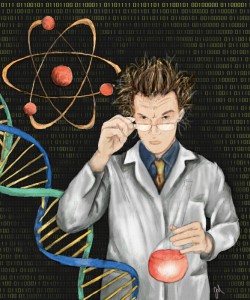An essay by Dr. Phillip “Pip” Jaminson, as provided by Michael Hudson
Art by Justine McGreevy
Welcome aspiring overlords, misanthropic geniuses, and sociopathic ne’er do wells! So you’ve decided to become a mad scientist rather than languish among the standard old run of the mill madmen? An astounding and thoroughly rewarding life awaits you should you survive the occasional dose of radiation and possible international military intervention. Combining the social disgust of the morally vacant with the limitless sense of superiority of the higher intellectual stock, we as mad scientists are the (somewhat) undisputed driving force behind the social and academic advancements that will shape the future. Standing apart from the common stock and rising above the wanton thuggery of the typical antisocial masses, we mad scientists bring a sense of refinement and nobility to everyday social deviance. Though I feel you are insignificant and beneath my notice, oh humble reader, I will gladly guide you on the path toward your new life as one of the elite and truly mad among us.
Method 1. Turning from traditional fields: Improper applications for proper science.
The first and simplest method of entering a life of mad science is of course to leave behind the shackles of the regular scientific world. This is a fairly common means of entering the field, but it does tend to attract the wrong sort of scientist from time to time. Drawbacks aside, the university educated scientist can bring wondrous benefits to the world of mad science given the proper amoral outlook and a focus on the proverbial “ends” rather than the “means.”
First, biology, widely regarded as the true forefather of our field, is fertile ground for the ambitious mad scientist. Reckless cloning experiments can replicate (or even resurrect) some of the most amazing creatures from history without limit. Vast legions of your “special children” can be created on a whim, all for the sake of science. If quality over quantity is more your style, forced mutations can combine the greatest physical characteristics of literally every animal in existence into one, perfect super being. Advances in genetic modification can even provide the necessary means to create entirely new forms of life, quite possibly the crowning achievement of any mad biologist.
Second, chemistry, long thought of as being more decorative than practical with its bubbling vials and curious odors, has emerged as the backbone of any mad scientific endeavor. A mass of unwitting test subjects can easily become an army of deranged, chemically enhanced super-soldiers with the proper application of a gaseous chemical agent. Detractors may not respect your ambitious–though only mildly carcinogenic–scientific pursuits, but your efforts will certainly garner more attention once you’ve demonstrated your ability to turn the world’s oceans into a sea of corrosive acid.
Third, the field of lasers, controlled explosions, and giant radioactive ants, more commonly known as physics. Actually, once you delve into the world of physics, you’re basically a mad scientist already, so this transition may not be much of an adjustment for you. Just turn up the power on those lasers and let the bombs fly. As for the ants, well, I’m not one to tell fellow scientists what to do with their own radioactive hordes, so you’re on your own there.
Finally, the fields of engineering and computer science, which I have chosen to discuss as one topic since they pair together so well. Vast, automated drone fleets circling the globe? Computers and engineering. Indestructible, mechanized juggernauts guarding your lair and/or lab? Computers and engineering. Unstoppable computer virus siphoning all of the world’s currency to your offshore account? That’s mostly computer science, but the virus was probably uploaded while you were encased in some sort of robotic exoskeleton, so I’ll call it a point for both.
Mad science is a path to greatness and is not forgiving toward mere dabblers, nor is it suited to the common intellectual. Some of the greatest minds in history have been shattered for the benefit of the most deviant fields of study, and it pains me to think that such minds have been able to mend themselves back into a state of functioning academic banality. All too often, the plentiful stores of knowledge contained within our field have been ransacked and pillaged for the oh so bile churning pursuit of altruism and the greater good. Anti-antibiotics were rendered useless by antibiotics, invasive telepathic implants were made obsolete by cellular technology, and, in the ultimate display of arrogance, black holes were stolen from us in their entirety. So to you seasoned academics casting in your lot with the world of mad science, I say this: leave behind your aspirations of university tenure and Nobel recognition. In this world, success is viewed through x-ray goggles, achievements are seized with tentacled limbs, and recognition is given by the prostrate masses trembling at your feet.

Mad science is a path to greatness and is not forgiving toward mere dabblers, nor is it suited to the common intellectual.
To read the rest of this story, check out the Mad Scientist Journal: Summer 2015 collection.
Dr. Phillip “Pip” Jamison, The Shame of Glasgow, was born in the chilly northern city of Glasgow, Montana. He is a respected and feared pioneer in the emerging field of orbital disintegration technology. He is the recipient of two honorary degrees from the University of Texas, which the university claims were granted under duress. The doctor’s whereabouts are currently unknown, which is exactly the way he wants it.
Michael Hudson is originally from Springfield, Missouri, and moved to Austin, Texas, while in the Army. He lives there with his girlfriend and their lazy, poop-machine of a cat, Prince.
Justine McGreevy is a slowly recovering perfectionist, writer, and artist. She creates realities to make our own seem slightly less terrifying. Her work can be viewed at http://www.behance.net/Fickle_Muse and you can follow her on Twitter @Fickle_Muse.
Follow us online: